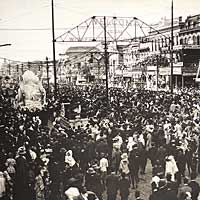 |

路易斯安那州紐奧良狂歡節(Mardi
Gras)的其中一景,1910年

|
 |
|
 |
紐奧良的狂歡節(Mardi
Gras Season)
地方性遺產
您會慶祝油膩星期二嗎?假如您住在路易斯安那州的紐奧良或任何墨西哥灣的沿岸都市,那麼您或許會。
每年,紐奧良居民都會歡慶狂歡節(Mardi
Gras),即法文的油膩星期二之意。這個節日發生在聖灰星期三的前一天,接下來就是直至復活節(Easter
Sunday)為止的大齋期。而大齋期是許多基督徒的絕食節期。將這一天稱做油膩星期二是因為它是大齋期開始前,最後一個可以吃肉及油膩食物的日子。
時至今日,紐奧良的狂歡節代表了一段狂歡及慶祝的時光,早在油膩星期二正式來臨的前幾個星期,許多名叫krewes(唸做"crews")的市內俱樂部會資助、主辦奢侈的遊行行列及面具舞會,而且接住遊行花車上拋向圍觀群眾的首飾是一件十分有趣的事。每一個krewe都有一位國王及一位皇后,他們直到舞會當夜才會揭曉自己的身份,這是有趣且神秘嘉年華會的一部分。
Do you celebrate Fat Tuesday? If you live in New Orleans, Louisiana, or any place else along the coast of the Gulf of Mexico, you probably do.
Every year, the people of New Orleans celebrate Mardi Gras, which is French for "Fat Tuesday." This holiday is the day before Ash Wednesday, and it begins a season of fasting, called Lent, for many Christians leading up to Easter Sunday. It's called Fat Tuesday because it's the last day that many people eat meat and fatty foods before Lent begins.
Today, Mardi Gras season in New Orleans is a time of merry-making and festivity. Many clubs in the city, called krewes (pronounced "crews"), sponsor extravagant parades and masked balls in the weeks leading up to Fat Tuesday. It's a lot of fun to try to catch the trinkets that are thrown to the crowds from the parade floats. Every krewe has a king and queen, whose identities are kept secret until the night of the ball. It's all part of the fun and mystery of Mardi Gras.

 1/1 頁
1/1 頁

關於地方性遺產

|





